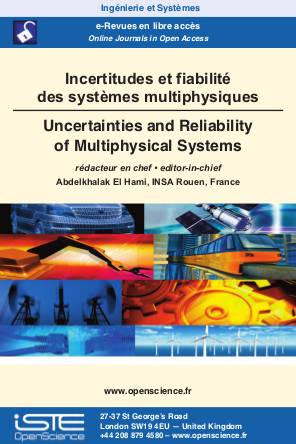

Ingénierie et systèmes > Accueil > Incertitudes et fiabilité des systèmes multiphysiques > Numéro
La méthode de Boltzmann sur réseau (MBR) a été utilisée de manière spectaculaire ces dernières années dans le domaine de la dynamique des fluides numérique. Cette méthode a été rarement appliquée aux écoulements hydrauliques. L’objectif de ce travail est de présenter le modèle que nous avons développé pour résoudre les équations des eaux peu profondes (EEPP) par la MBR. Dans un premier temps le modèle a été vérifié sur des cas académiques en hydraulique. Dans un second temps, le modèle a été appliqué au cas schématique de la propagation de l’onde de marée dans la lagune de Oualidia (côte Ouest du Maroc). Le modèle ainsi développé a produit avec une bonne précision les caractéristiques de ces trois écoulements étudiés et en particulier la propagation de l’onde de marée.
The main objective of this research is to define the best strategies to contribute to the industrialization of the Additive Manufacturing (AM) technology. The industrialization of AM needs to perform several research to deal with the different failure scenarios. The high failure rate leads to arise the total cost which can be a big obstacle to industrialize the AM technology. So, the different failures should be first identified and next treated. The uncertainty should be considered at several levels such as filament material properties, shape complexity, AM process... One of these uncertainty sources is preheating where a failure scenario can be occurred because of preheating issues which related to AM process parameters. In fact, the preheating plays an important role at the adhesion levels, especially at the beginning of the AM process. Considering the preheating uncertainty should lead to increase the reliability level of the AM processes. To highly increase the preheating temperatures, the quality of the products may be affected such as their surface quality and final dimensions. So, there is a need to perform a statistical study considering different preheating parameters. In this work, a complex shape is considered to perform several studies at different preheating temperatures. This complexity of the studied example necessitates to add some supports to obtain the required geometry. An experimental study on PLA (Polylactic acid) material is carried out to define the most reliable preheating parameters for different models. According to the present example and several realistic applications, it is concluded that when manufacturing PLA materials, the best choices of the preheating temperatures are 240°C for the extruder and 100°C for the platform. This way we reduce the likelihood of failure due to adhesion issues. The preheating temperatures largely affect the adhesion levels at the beginning of the AM process. Even for the same conditions, there is no guarantee to obtain the same results which leads to consider the uncertainty concept at each level of the AM process. In addition to the different findings of the preheating effect, this paper provides the newcomers to AM area with some basic concepts and several probable failure scenarios in a simple way.
In certain industries such as aviation, the different operations are very complex, and a small error may lead to a catastrophe. So, there is a strong motivation to establish an effective maintenance program to avoid any probable error. A concept called Reliability-Centered Maintenance (RCM) was found in the 1960s and initially oriented towards maintaining airplanes. In this work, we first present some existing RCM standards since standardization is considered as an important element of maintainability. Four significant criteria are next selected in order to establish a comparison of four RCM standards. These comparison criteria are : 1) Categories of failure consequences, 2) Treatment of hidden failures, 3) Management of different consequences, and 4) Decision diagrams. Three of them are related to reliability improvement and the last one is related to the RCM process it-self. Here, we present and discuss the similarities and differences considering the selected criteria. In addition, we add new diagrams to combine between the different RCM standards which paves the way to establish a generalized RCM standard in the future works. As a result, NAVAIR is selected to be the most suitable standard to determine the significant functional failures in terms of safety, operations, environment, and economy.
La planification de la trajectoire de couverture est un domaine d’étude fascinant pour les roboticiens, avec de nombreuses études disponibles dans la littérature de recherche. Pendant la phase de planification de la trajectoire. Comme la consommation d’énergie est fonction de la trajectoire qu’elle va prendre, le problème de consommation d’énergie sera partiellement converti en un problème d’optimisation de trajectoire. Pour la première phase, nous comprimerons le problème en un plan 2d, qui est connu sous le nom de "problème du voyageur de commerce". Il n’existe pas de méthode connue de résolution du "problème du voyageur de commerce" qui permette d’obtenir des réponses exactes en un temps raisonnable pour les cas de grande taille (un grand nombre de villes). En raison de l’explosion combinatoire, nous devrons souvent nous contenter de solutions approximatives pour ces énormes situations. Dans cet article on va montrer une heuristique et faire une simulation numérique du plan de vol puis on va caractériser l’effet de cette optimisation sur le temps de vol.

2025
Volume 25- 9
Numéro 12024
Volume 24- 8
Numéro 12023
Volume 23- 7
Numéro 12022
Volume 22- 6
Numéro 12021
Volume 21- 5
Numéro 22020
Volume 20- 4
Numéro 12019
Volume 19- 3
Numéro 12018
Volume 18- 2
Numéro 22017
Volume 17- 1
Optimisation et Fiabilité